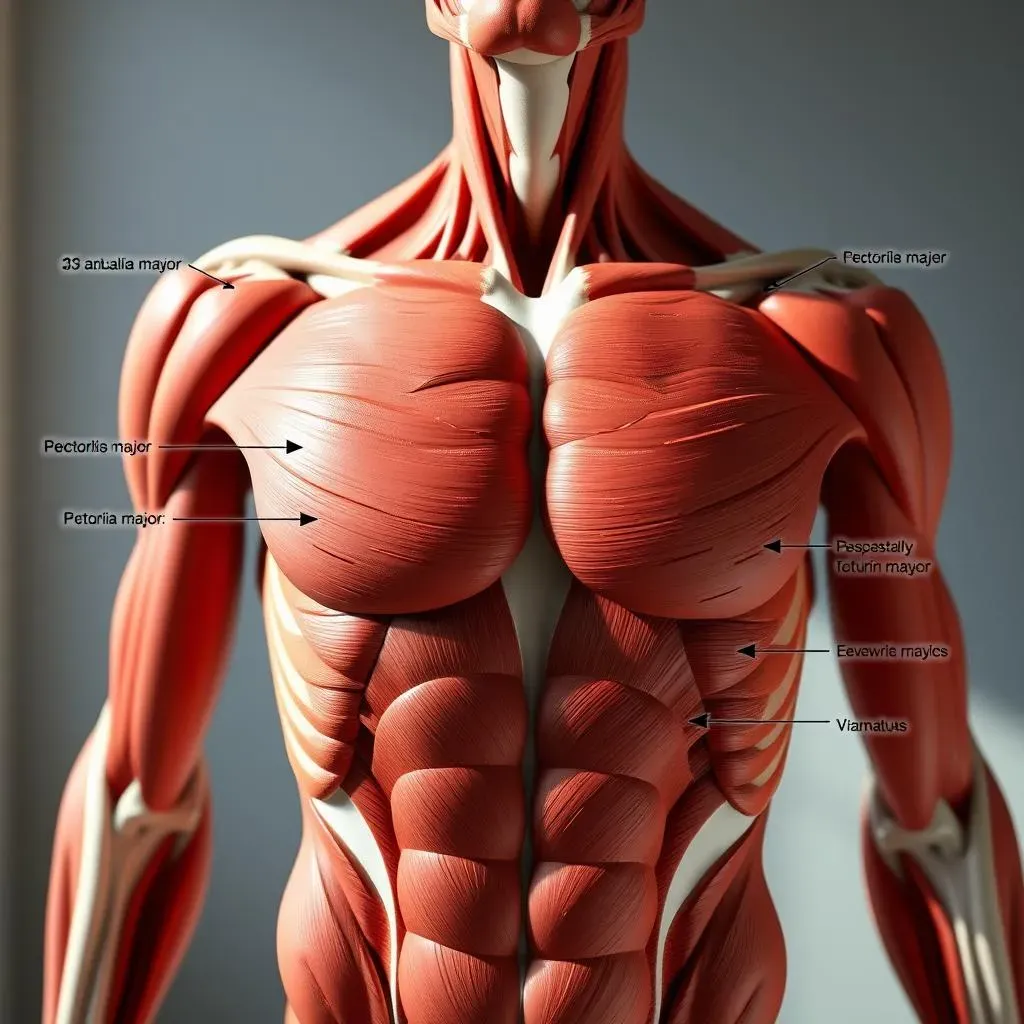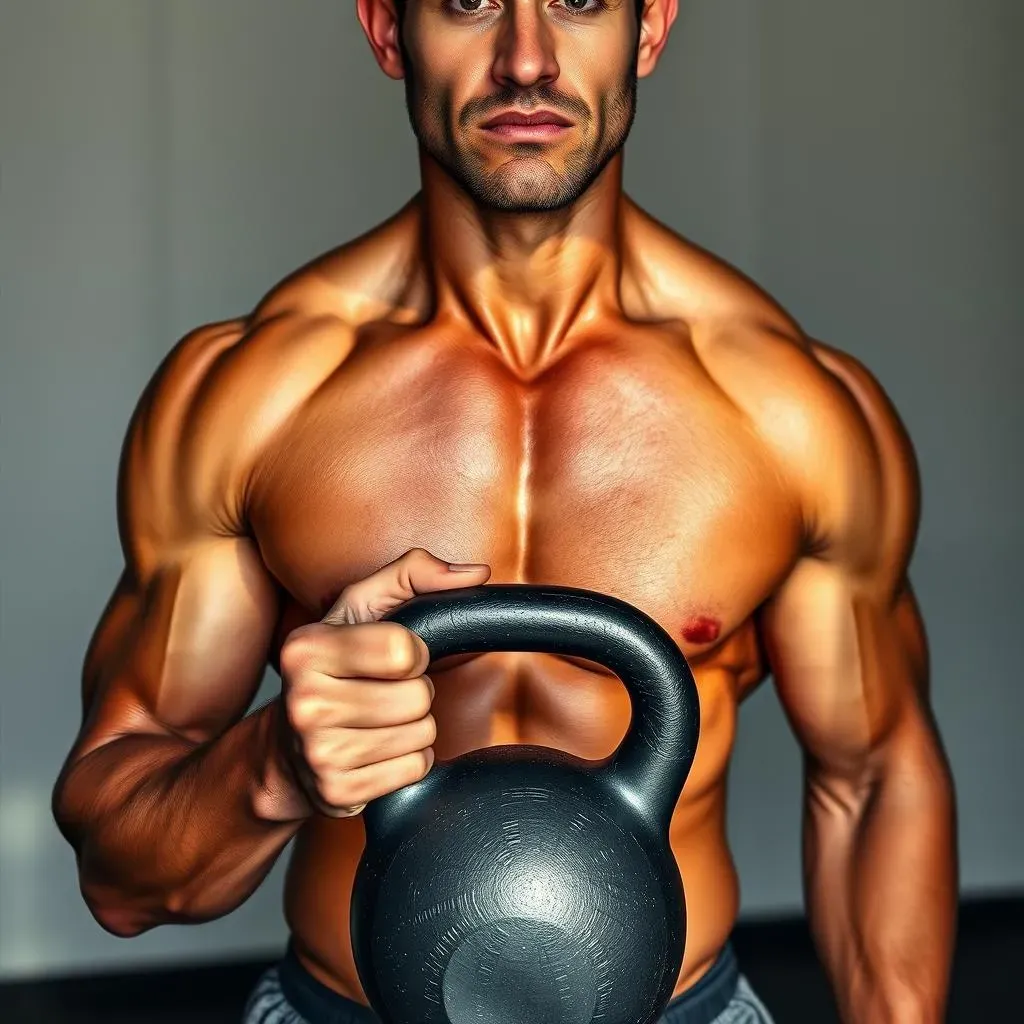Table of Contents
Are you tired of the same old boring chest workouts? Do you feel like you're just pushing metal around without really feeling the burn? Well, maybe it's time to ditch the traditional bench press and grab a kettlebell. This isn't your grandpa's bodybuilding routine; we're talking about dynamic, flowing movements that build real strength and power. Forget isolating your "pecs" – we're going to work your chest the way it's meant to be worked, with full-body engagement. In this article, I’ll walk you through the ins and outs of an effective chest workout with kettlebell, explaining why this approach is so beneficial. You'll learn how the chest muscles work, discover five killer kettlebell exercises for chest, and get a sample routine to get you started. Plus, I'll touch on some other kettlebell moves that indirectly contribute to chest development. So, if you're ready to shake things up and add some real functionality to your chest training, keep reading! It’s time to see what a kettlebell can do for you.
Understanding Your Chest Muscles: More Than Just a "Pec"

Understanding Your Chest Muscles: More Than Just a "Pec"
so you think you know your chest, right? Big ol’ pecs, bench press, the whole nine yards. But here's the thing: it's more complex than just that single muscle you see in the mirror. We're talking about a team of muscles working together, and knowing their roles is key to getting the most out of your workouts, especially when you're using a kettlebell. You’ve got your pectoralis major, the big guy that makes up most of your chest’s surface, responsible for pushing, pressing, and bringing your arms across your body. Then there’s the pectoralis minor, which is like its smaller, more secretive sidekick, sitting underneath and helping to stabilize your shoulder blade. And they don't work in isolation; they're part of a bigger system that includes your shoulders, back, and even your core. When you understand how these muscles work together, you can start to move in a more functional way, and you'll see that a kettlebell is not just for swinging around, it's a tool that can unlock real strength and power in your chest.
Kettlebell Chest Workout: 5 Exercises to Pump Up Your Pecs

Kettlebell Chest Workout: 5 Exercises to Pump Up Your Pecs
The Kettlebell Floor Press
Alright, let's get into the good stuff, the exercises that'll make your chest scream (in a good way, of course). First up is the Kettlebell Floor Press. It's like a bench press, but on the floor, and with a kettlebell, which means more stability work for your core. Lie on your back with a kettlebell in one hand, bent at the elbow, and your other hand on the ground for balance, press the kettlebell straight up towards the ceiling, making sure your elbow doesn't lock out at the top. Keep your core tight and your back flat on the floor. Lower it slowly and repeat. It’s simple but effective.
Why do I love this move? It’s not just about the chest; it’s about the whole package. The floor provides a stable surface, allowing you to focus on the pressing motion, and your core has to work harder to keep you from wobbling. This is what I call functional strength, building real-world power.
Half Get Up Chest Press
Next, we've got the Half Get Up Chest Press, which is a bit more of a challenge. It’s not only a chest exercise; it’s a full-body move that builds strength and coordination. Start with the kettlebell on the floor, get into a half-kneeling position, and press the kettlebell up overhead. Think of it as a mini Turkish Get Up. This move is great because it forces you to engage your core, shoulders, and chest all at once. It's not just about pushing weight; it's about controlling your body through space. And you know what? It’s kind of fun too.
I remember when I first tried this, I was all over the place. It took some time to get the hang of it, but once you do, it's a game-changer. It really connects your upper body to your lower body, making it a powerful functional move.
Exercise | Why it's great | Tips |
|---|---|---|
Kettlebell Floor Press | Stable, core-engaging | Keep back flat, control descent |
Half Get Up Chest Press | Full-body, builds coordination | Engage core, control movement |
Stability Ball Kettlebell Chest Press
Now, for a real stability test, let's talk about the Stability Ball Kettlebell Chest Press. This is where things get a little wobbly, but that's the point. Lie back on a stability ball, holding a kettlebell in one hand, and press it up towards the ceiling. The unstable base forces your core and stabilizing muscles to work overtime, making this a killer chest and core move. It's like the floor press, but with an added challenge. It's also a great way to improve your balance and coordination.
I've seen people shake like leaves when they try this for the first time, but trust me, it's worth it. It teaches you to control your body in a way that you just can't get from a stable bench. It's a humbling experience, but in a good way. It shows you where you're lacking and what you need to work on.
Full Chest Workout with Kettlebell: Routine and Tips for Results

Full Chest Workout with Kettlebell: Routine and Tips for Results
so now you know the moves, but how do you put it all together? Let's talk about a full chest workout with kettlebell that'll actually give you results. It's not about just randomly doing a few reps here and there; it's about having a plan. We're going to combine these exercises into a routine that'll hit your chest from all angles, and I'll give you some tips to make sure you're getting the most out of every session. Remember, consistency is key. You can do the best workout in the world, but if you're not doing it regularly, you won't see the progress you want. Aim for at least two to three chest workouts per week, with a day of rest in between. Also, it’s important to listen to your body; if you need an extra day of rest, take it. There's no point in pushing yourself so hard that you end up injured.
Here is a sample routine to get you started. Remember, you can adjust the reps and sets based on your fitness level. If you're just starting out, focus on good form first. It's better to do fewer reps with good form than more reps with bad form. And don't be afraid to take breaks when you need them. Rest is just as important as the workout itself. It’s when your muscles recover and grow stronger.
Exercise | Sets | Reps | Rest |
|---|---|---|---|
Kettlebell Floor Press | 3 | 8-12 | 60 seconds |
Half Get Up Chest Press | 3 | 6-10 per side | 60 seconds |
Stability Ball Kettlebell Chest Press | 3 | 8-12 | 60 seconds |
Now that you have a routine, let's talk about some tips to make it even more effective. First, focus on the squeeze. When you're pressing the kettlebell, think about squeezing your chest muscles at the top of the movement. It's all about engaging the right muscles. Second, don't rush the movement. Control the weight on the way down just as much as you do on the way up. This is where you really build strength. Third, don't forget about your core. Your core is the foundation of all your movements. Keep it engaged throughout each exercise. And finally, remember to breathe. It sounds simple, but a lot of people hold their breath when they're lifting. Breathe in on the way down and out on the way up. This helps you maintain stability and power.
I remember when I first started, I was so focused on just lifting the weight that I forgot about all these little details. It wasn't until I started focusing on form, control, and breathing that I really started to see results. It's like the difference between just throwing a ball and actually throwing a good ball. The technique makes all the difference. So take your time, focus on the details, and you'll be amazed at how much more effective your workouts become. This is your body, and it's worth the effort to do it right.
Beyond the Basics: Other Kettlebell Moves for Chest Development

Beyond the Basics: Other Kettlebell Moves for Chest Development
Indirect Chest Work: It's All Connected
so you've nailed the main chest exercises, but let's get real – your chest doesn't work in isolation. It's part of a team, and that team includes your shoulders, back, and even your core. So, you know what? Some of the best kettlebell moves for chest development aren't even direct chest exercises. Think about overhead presses, for example. Every time you push that kettlebell overhead, your chest muscles are firing to help stabilize your shoulder joint. It’s a subtle but crucial role, and it contributes to overall chest strength and development. These movements are like the unsung heroes of chest training. They might not be the flashiest, but they're essential for building a balanced and functional physique.
I always tell people, it's not just about the big, obvious muscles. It's about training the whole system. When you’re doing a movement like an overhead press, you’re not just building shoulder strength; you’re also improving your chest stability and overall coordination. And that’s where the real magic happens. It's like the difference between building a house with just a hammer and building it with a full set of tools. When you use all the tools you've got, you get a much better result.
The Mighty Turkish Get-Up
Next up, let's talk about the Turkish Get-Up. Yes, I know, it seems like a full-body circus act, but hear me out. This move is like a Swiss Army knife for your body, and it indirectly works your chest in a big way. Think about it: as you move through each phase of the get-up, your chest muscles are constantly engaged to stabilize your shoulder and keep the kettlebell overhead. It’s a constant, low-level activation that builds endurance and stability in your chest muscles. It’s not the kind of pump you get from a chest press, but it’s a functional strength that translates to real-world power.
I’ll admit, the Turkish Get-Up can be a bit intimidating at first. It’s a complex movement, and it takes time to master. But once you do, it’s a game-changer. It’s not just about lifting a weight; it’s about controlling your body through space. And that’s where the real magic happens. It’s like learning to play a musical instrument. At first, it’s awkward, but with practice, it becomes fluid and beautiful.
Exercise | Why it's great | Chest Benefit |
|---|---|---|
Overhead Press | Builds shoulder strength and stability | Stabilizes shoulder and chest muscles |
Turkish Get-Up | Full-body coordination and strength | Constant chest engagement for stability |
A Word of Caution: The Crush Grip Press
Now, before you go crazy with all these new moves, let's talk about one exercise I actually advise against: the Crush Grip Kettlebell Chest Press. While it might seem like a good idea in theory, it's actually pretty risky. The idea is that you hold the kettlebell by the sides of the handle and press it up, which is supposed to activate your chest more. However, this grip puts a ton of stress on your wrists and elbows. It's not worth the risk of injury for a little extra chest activation. I’ve seen too many people get hurt trying this move, and I'd rather you focus on the safer, more effective moves we've already talked about. There are plenty of other ways to build a strong chest without risking a wrist or elbow injury.
Look, I’m all about pushing your limits, but not at the expense of your body. There are some moves that are just not worth the risk, and the Crush Grip Press is one of them. It’s like trying to drive a car with a flat tire. You might be able to do it, but it’s not going to be pretty. It’s important to listen to your body and make smart choices about your training. After all, we want to be able to train for the long haul, not just for today.
Wrapping Up: Your Kettlebell Chest Journey
So, there you have it—a solid introduction to chest workouts with kettlebells. We've explored the muscles involved, learned five effective exercises, and even touched on some bonus moves. Remember, the key to success isn't just about lifting heavy but about moving well and engaging your whole body. Ditch the isolation mindset and embrace the dynamic nature of kettlebell training. Don’t be afraid to experiment with these exercises, find what works best for you, and always prioritize proper form over ego. This is about building a strong, functional chest that not only looks good but also serves you in your daily life. Now, go grab that kettlebell and get to work – your chest will thank you for it!